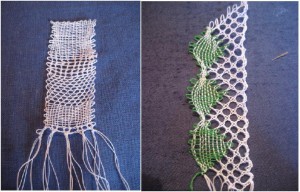‘We’re bobbin’ and bobbin’ and bobbin’ and bobbin’’ is what I like to sing to myself when cataloguing bobbins and other lacemaking equipment (much to Felicity’s annoyance, I’m sure). This weekend I went on a beginners’ bobbin lacemaking course at the Weald and Downland Museum. Lace is one of those crafts that I’ve always wanted to have a go at – it’s mesmerising to watch and fascinating to think that such beautiful things can be made by weaving some pieces of string. I also thought that having a go at making lace would help me with cataloguing, by giving me a better understanding of how the equipment is used, and hopefully giving me a personal connection to it which would make it more interesting (as with the baskets).
Lacemaking was an established craft in England by the seventeenth century, with centres of lacemaking appeareing in Devon, Buckinghamshire, Bedfordshire and Northamptonshire. The industrial revolution led to the creation of machine lace, which had an enormous impact on the lacemaking industry, and today lacemaking is mostly done for pleasure. There are two main types of lace – bobbin lace and needle lace – and we were learning the bobbin method on our course. The Lace Guild’s website is good if you want to find out more.
We began by making a pattern for our lace, pricking the design we were going to create into a piece of thick card. We then pinned the pattern to the pillow, a firm padded cushion on which you work. Pillows were traditionally packed with straw, and sometimes have a roller around which the lace can be wound as the length of the work increases.

Left: 51/829 Lacemaking pattern from MERL. Right: The pattern we used on our second piece on the course.
We wound the threads onto the bobbins by hand (although you can also use a machine if you need a lot of thread). Bobbins come in a variety of shapes, sizes and materials, including wood, horn and plastic, and are often decorated in various ways – with pewter bands, inscriptions, inlays etc. We used ‘spangled’ bobbins – bobbins with beads on the end to weight them and help keep the thread taut.

Left: 51/238 Assorted decorative bobbins with spangles at MERL, from Ickford, Buckinghamshire. Right: Plastic bobbins with spangles that I used.
We stuck pins into the top row of the pattern and hung the thread/bobbins on them and began to make lace. I won’t say it’s simple, but if you can get the hang of it, it’s quite rhythmic. You work four bobbins at a time, moving them over each other to the left or to the right (in combination) to create the stitches, and hold the stitches in position by pushing pins through the pricked holes in the pattern and into the pillow.
We spent six hours on the course, although probably only about 4.5 hours making lace once you take coffee breaks into account. In that time we each made two pieces of torchon lace – one about 5cm x 2cm and the other 7cm x 2cm. It certainly isn’t a ‘quick’ craft – in fact, I would think it is one of the most time intensive crafts there is.
We have quite a lot of lacemaking equipment at MERL, including bobbins, a bobbin-winding machine, pillows, patterns, a candleblock for maximising the light from the candles, and a warming pot – a pot filled with hot wood ashes from a baker and placed under the chair of the lacemaker to keep her warm (a fire would create soot and dirty the work). Have a look at our catalogue to find out more about our lacemaking objects.







